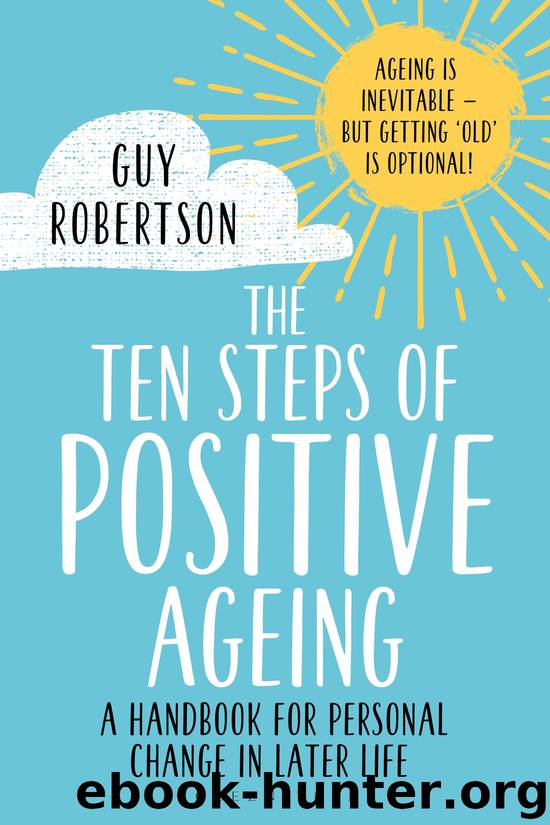The Ten Steps of Positive Ageing by Guy Robertson

Author:Guy Robertson
Language: eng
Format: epub
Publisher: Bloomsbury Publishing
A higher score indicates that your inner disposition tends to be more optimistic than pessimistic. People with a higher score tend to instinctively expect more good things than bad things to happen in the future.
Developing optimism
People tend to see optimism as a fixed personality trait and as a result tend to label themselves and others as being either optimistic or pessimistic. This is too simplistic, and can be harmful if not challenged. An optimistic outlook is not an either/or thing. We are all somewhere along a sliding scale of optimism and pessimism. Not only that, we can be more or less optimistic depending on the context. For example, we might be very pessimistic about the weather prospects for our holiday, whilst being very optimistic about the chances of our survival from a cancer diagnosis. In other words, optimism and pessimism can co-exist in each of us and vary depending on circumstances. Whilst we might have been born with a disposition that is relatively pessimistic, we can change that if we want. We can actually learn to be more optimistic.
Martin Seligman, an American psychologist and probably the primary instigator of the positive psychology movement, has written and researched extensively on optimism and explains that it is best understood as an ‘attributional style’. What that means is that our tendency towards optimism or pessimism is a reflection of how we explain or attribute the causes and implications of events that happen to us. When something difficult or upsetting happens, optimists and pessimists react in different ways to three key dimensions of the problem:
• Permanence – is the situation going to last for ever or will it pass quite quickly?
• Pervasiveness – does it affect many areas of my life or just the one that it first impacted on?
• Personalisation – to what extent have I caused the situation?
Seligman’s research has shown that optimistic people tend to interpret a difficult situation as:
• Transient: in other words, they believe that the situation is a temporary thing and whatever difficulty is experienced now will fade away in the future. It is therefore not a permanent feature of their life.
• Specific to that one area of life and doesn’t ‘leak’ into or contaminate other aspects. (The difficulty is therefore not pervasive.)
• The result of external events or conditions and therefore not a challenge to their confidence in their own abilities.
Pessimistic people, on the other hand, tend to interpret a difficult situation as:
• Long-lasting, or so regular as to be an almost permanent feature of their lives.
• Something which undermines other important aspects of their lives. Their wellbeing can collapse like a house of cards over this one issue and the unease over the difficulty tends to pervade the rest of their lives.
• Something that they have brought upon themselves because of their own failings. They tend to ignore any external causes and personalise the reasons for the difficulty: ‘It is my fault’.
We can illustrate how this might play out in later life through the following example. One of the most common accidents, as we age, is to have a fall and break a bone in the process.
Download
This site does not store any files on its server. We only index and link to content provided by other sites. Please contact the content providers to delete copyright contents if any and email us, we'll remove relevant links or contents immediately.
Tuesdays with Morrie by Mitch Albom(4690)
Adulting by Kelly Williams Brown(4487)
Pillow Thoughts by Courtney Peppernell(4208)
The Book of Joy by Dalai Lama(3899)
A Woman Makes a Plan by Maye Musk(3202)
The Boy, the Mole, the Fox and the Horse by Charlie Mackesy(2998)
Tuesdays With Morrie by Mitch Albom(2694)
The Alchemist by Paulo Coelho(2644)
A New Earth: Awakening to Your Life's Purpose by Eckhart Tolle(2597)
The Four Agreements: A Practical Guide to Personal Freedom (A Toltec Wisdom Book) by Ruiz Don Miguel(2435)
The Charisma Myth: How Anyone Can Master the Art and Science of Personal Magnetism by Cabane Olivia Fox(2373)
Untamed by Glennon Doyle(2296)
Why Is God Laughing?: The Path to Joy and Spiritual Optimism by Deepak Chopra(2215)
Manson, Mark - The Subtle Art of Not Giving a F*ck by Manson Mark(1902)
Tiny Habits by BJ Fogg(1899)
The Happiness Advantage: The Seven Principles of Positive Psychology That Fuel Success and Performance at Work by Shawn Achor(1767)
Warrior of the Light by Paulo Coelho(1680)
The Boy, The Mole, The Fox and The Horse by Mackesy Charlie(1644)
Think and Grow Rich! by Napoleon Hill(1632)
